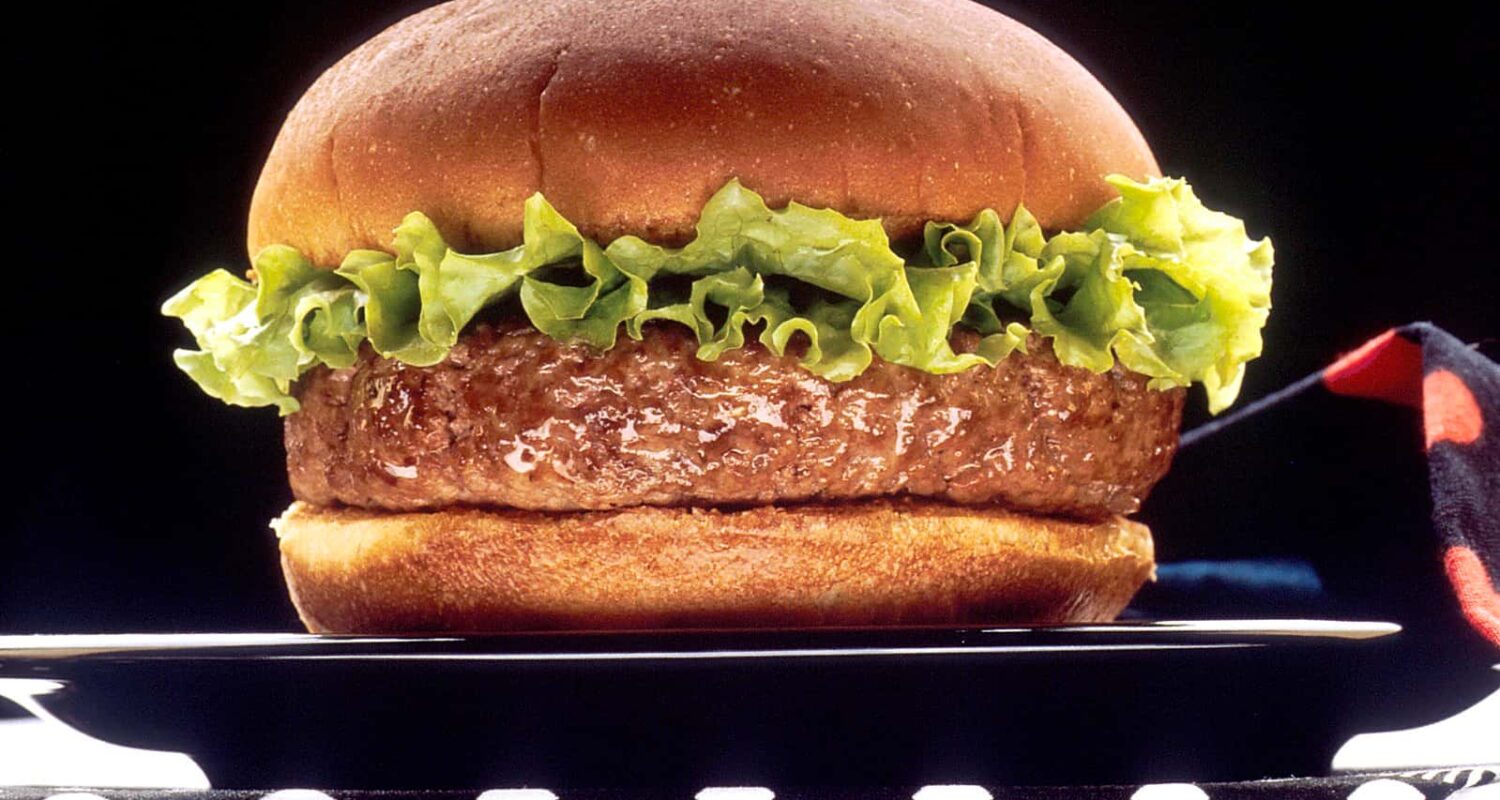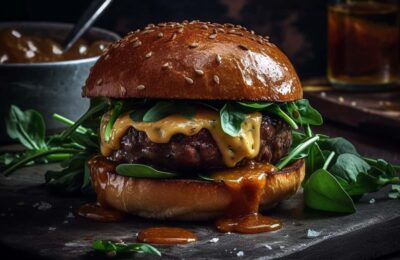The beloved burger stands as an American culinary icon, but its exact origins are shrouded in mystery and debate. The journey of this classic dish intertwines with tales of innovation, adaptation, and cultural fusion.
Evolution of a Classic Dish

The concept of placing meat between bread isn’t a recent invention. History hints at ancient civilizations using ground meat patties, a precursor to the modern burger. However, the transformation of this simple idea into the widely adored burger we know today took a unique course in the United States.
Why was it called a burger?
The term “burger” finds its etymological roots in the name of the dish that inspired it—the hamburger. The hamburger’s name itself is a nod to the German city of Hamburg, renowned for its beef, particularly its minced or ground beef dishes:
- During the late 19th and early 20th centuries, German immigrants brought their culinary traditions, including seasoned and ground beef patties, to the United States. In various ports of entry like New York City, these immigrants introduced dishes similar to what became known as the hamburger steak;
- The dish gained popularity, especially at county fairs and festivals, where vendors served cooked ground beef patties, often between slices of bread, for convenient consumption on the go. As this dish gained traction and became a staple in American cuisine, it began being referred to as the “hamburger sandwich” or simply “hamburger.;
- The transition from “hamburger” to “burger” was a natural linguistic abbreviation, a common phenomenon in English where longer words or phrases are shortened for convenience. The “-er” suffix, denoting something that pertains to or is connected with, was appended to many food-related terms at the time, thus giving rise to “burger.”
Ultimately, “burger” became a versatile term encompassing not just the traditional beef patty between buns but also its myriad variations—cheeseburgers, veggie burgers, chicken burgers, and more. It has evolved to represent a broader category of sandwiches that feature a patty as the central element, regardless of its composition or accompanying ingredients.
The Controversial Beginnings
One prevailing story traces back to the late 1800s, where the burger found its roots in the hands of a humble cook, possibly at a fair or a food stall. Legend has it that this unnamed visionary cooked beef patties and placed them between two slices of bread, creating a convenient, handheld meal for on-the-go patrons. This narrative symbolizes the birth of fast food culture in America.
However, tracing the burger’s true inventor becomes a challenge due to multiple claims and varying narratives. Some attribute its creation to specific individuals or restaurants, each claiming the title of the burger’s originator. The debate persists, weaving a captivating web of stories and theories surrounding this cultural phenomenon.
Key Players and Milestones
Several names frequently emerge in the quest to pinpoint the burger’s inventor. Among them, Louis Lassen, at his New Haven, Connecticut, establishment, allegedly served the first hamburger in the early 20th century. Meanwhile, the White Castle chain’s establishment in 1921 added to the burger’s popularity, pioneering the modern fast-food concept and standardizing its production.
As time progressed, innovations like the introduction of the cheeseburger and regional variations further enriched the burger’s legacy. From the California-style burger adorned with avocado and sprouts to the classic diner-style with pickles and onions, each iteration adds a layer to its storied history.
A Variety of Types of Burgers
Burgers, once a simple beef patty between two buns, have evolved into a myriad of mouthwatering variations that cater to diverse tastes and culinary preferences. From classic renditions to innovative twists, here’s a tantalizing tour of the rich variety in the world of burgers.
- Classic Cheeseburger. The quintessential cheeseburger remains a timeless favorite—a juicy beef patty adorned with melted cheese, crisp lettuce, ripe tomatoes, sliced onions, pickles, and a generous slather of savory sauce, all snugly enclosed in a soft bun. Its familiarity and comforting flavors make it a go-to choice for many burger enthusiasts;
- Gourmet Creations. The culinary world has embraced the burger as a canvas for innovation. Gourmet variations often feature high-quality ingredients like Angus beef, artisanal cheeses, caramelized onions, arugula, truffle-infused sauces, and brioche buns. These upscale interpretations elevate the humble burger into a gourmet delicacy, enticing food connoisseurs seeking a refined dining experience;
- Regional Delights. Across the United States, regional burgers offer a taste of local flavors and traditions. The West Coast boasts its signature avocado-laden burgers, while the South celebrates its love for barbecue by incorporating smoked meats and tangy sauces. From the East Coast’s seafood-infused patties to the heartland’s hearty and meaty offerings, each region puts its unique stamp on the beloved burger;
- Vegetarian and Vegan Options. In response to changing dietary preferences, vegetarian and vegan burgers have gained popularity. These alternatives utilize plant-based proteins like black beans, chickpeas, mushrooms, or soy, crafted into patties and paired with fresh vegetables, vegan cheese, and flavorful sauces. Their rise reflects a growing demand for sustainable and cruelty-free dining choices;
- Global Influences. Burgers have transcended borders, inspiring international adaptations that reflect diverse cultural influences. The Japanese “Ramen Burger” replaces the traditional bun with ramen noodles, while India’s “Vada Pav” features a spiced potato patty served with chutneys. From Middle Eastern-inspired falafel burgers to Korean bulgogi-infused creations, global fusion burgers offer a tantalizing fusion of flavors;
- Health-Conscious Offerings.For health-conscious burger aficionados, lighter options abound. Turkey or chicken burgers offer a leaner alternative to beef, while lettuce wraps replace traditional buns, reducing carb intake. Quinoa, lentil, or tofu-based patties cater to those seeking protein-rich and plant-powered alternatives.
The diverse landscape of burgers showcases the culinary creativity and adaptability of this beloved dish. Whether honoring tradition or pushing culinary boundaries, the sheer variety of burgers ensures there’s a perfect patty for every palate and dietary preference.
As we savor these diverse renditions, each bite tells a flavorful story of innovation, culture, and a universal love for this iconic dish—a true testament to the ever-evolving world of gastronomy.
Cultural Impact and Global Spread
Beyond its culinary significance, the burger’s impact extends far and wide, becoming a cultural symbol synonymous with American cuisine. Its popularity transcends borders, evolving into a global phenomenon with diverse interpretations worldwide. From street vendors to Michelin-starred restaurants, the burger’s versatility and universal appeal continue to captivate taste buds globally.
The story of who invented the burger remains an intriguing puzzle, entwined with historical anecdotes and culinary lore. Despite the lack of a definitive answer, the burger’s evolution from a humble creation to an international sensation illustrates the power of culinary innovation and cultural assimilation.
As we savor each bite of this iconic dish, we honor not just the unknown innovators but also the spirit of experimentation and adaptation that has made the burger an enduring symbol of culinary creativity and American culture.
Wrapping Up
In the quest to unveil the burger’s inventor, the journey itself reveals the essence of culinary evolution and cultural amalgamation. Whether tracing it back to a humble cook or a renowned establishment, the burger’s impact on society and its place in the hearts of millions remain unwavering.
As we indulge in this timeless classic, let us celebrate not just its origins but also the spirit of innovation and community that continues to shape our culinary experiences.
Conclusion
The burger’s invention is a tale interwoven with history, culture, and a dash of mystery. Its exact origins may elude us, but the enduring love for this culinary marvel persists. As we relish its flavors and debate its beginnings, the burger remains a symbol of innovation, adaptation, and the diverse tapestry of American cuisine.


